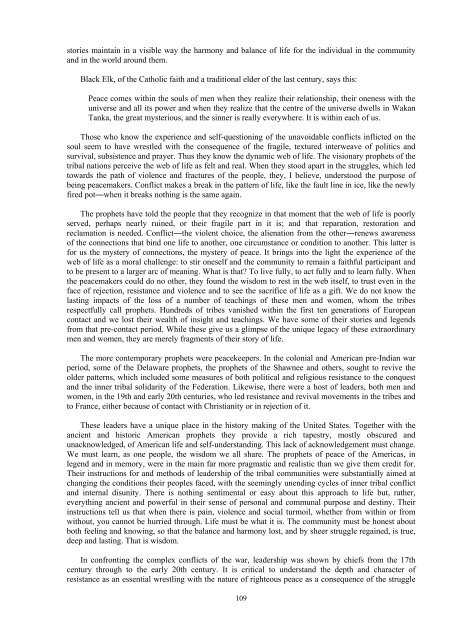traditional knowledge conference 2008 te tatau pounamu
traditional knowledge conference 2008 te tatau pounamu
traditional knowledge conference 2008 te tatau pounamu
Create successful ePaper yourself
Turn your PDF publications into a flip-book with our unique Google optimized e-Paper software.
stories maintain in a visible way the harmony and balance of life for the individual in the communityand in the world around them.Black Elk, of the Catholic faith and a <strong>traditional</strong> elder of the last century, says this:Peace comes within the souls of men when they realize their relationship, their oneness with theuniverse and all its power and when they realize that the centre of the universe dwells in WakanTanka, the great mys<strong>te</strong>rious, and the sinner is really everywhere. It is within each of us.Those who know the experience and self-questioning of the unavoidable conflicts inflic<strong>te</strong>d on thesoul seem to have wrestled with the consequence of the fragile, <strong>te</strong>xtured in<strong>te</strong>rweave of politics andsurvival, subsis<strong>te</strong>nce and prayer. Thus they know the dynamic web of life. The visionary prophets of thetribal nations perceive the web of life as felt and real. When they stood apart in the struggles, which ledtowards the path of violence and fractures of the people, they, I believe, understood the purpose ofbeing peacemakers. Conflict makes a break in the pat<strong>te</strong>rn of life, like the fault line in ice, like the newlyfired pot―when it breaks nothing is the same again.The prophets have told the people that they recognize in that moment that the web of life is poorlyserved, perhaps nearly ruined, or their fragile part in it is; and that reparation, restoration andreclamation is needed. Conflict―the violent choice, the alienation from the other―renews awarenessof the connections that bind one life to another, one circumstance or condition to another. This lat<strong>te</strong>r isfor us the mys<strong>te</strong>ry of connections, the mys<strong>te</strong>ry of peace. It brings into the light the experience of theweb of life as a moral challenge: to stir oneself and the community to remain a faithful participant andto be present to a larger arc of meaning. What is that? To live fully, to act fully and to learn fully. Whenthe peacemakers could do no other, they found the wisdom to rest in the web itself, to trust even in theface of rejection, resistance and violence and to see the sacrifice of life as a gift. We do not know thelasting impacts of the loss of a number of <strong>te</strong>achings of these men and women, whom the tribesrespectfully call prophets. Hundreds of tribes vanished within the first <strong>te</strong>n generations of Europeancontact and we lost their wealth of insight and <strong>te</strong>achings. We have some of their stories and legendsfrom that pre-contact period. While these give us a glimpse of the unique legacy of these extraordinarymen and women, they are merely fragments of their story of life.The more con<strong>te</strong>mporary prophets were peacekeepers. In the colonial and American pre-Indian warperiod, some of the Delaware prophets, the prophets of the Shawnee and others, sought to revive theolder pat<strong>te</strong>rns, which included some measures of both political and religious resistance to the conquestand the inner tribal solidarity of the Federation. Likewise, there were a host of leaders, both men andwomen, in the 19th and early 20th centuries, who led resistance and revival movements in the tribes andto France, either because of contact with Christianity or in rejection of it.These leaders have a unique place in the history making of the Uni<strong>te</strong>d Sta<strong>te</strong>s. Together with theancient and historic American prophets they provide a rich tapestry, mostly obscured andunac<strong>knowledge</strong>d, of American life and self-understanding. This lack of ac<strong>knowledge</strong>ment must change.We must learn, as one people, the wisdom we all share. The prophets of peace of the Americas, inlegend and in memory, were in the main far more pragmatic and realistic than we give them credit for.Their instructions for and methods of leadership of the tribal communities were substantially aimed atchanging the conditions their peoples faced, with the seemingly unending cycles of inner tribal conflictand in<strong>te</strong>rnal disunity. There is nothing sentimental or easy about this approach to life but, rather,everything ancient and powerful in their sense of personal and communal purpose and destiny. Theirinstructions <strong>te</strong>ll us that when there is pain, violence and social turmoil, whether from within or fromwithout, you cannot be hurried through. Life must be what it is. The community must be honest aboutboth feeling and knowing, so that the balance and harmony lost, and by sheer struggle regained, is true,deep and lasting. That is wisdom.In confronting the complex conflicts of the war, leadership was shown by chiefs from the 17thcentury through to the early 20th century. It is critical to understand the depth and charac<strong>te</strong>r ofresistance as an essential wrestling with the nature of righ<strong>te</strong>ous peace as a consequence of the struggle109
















